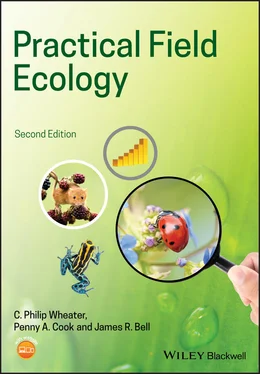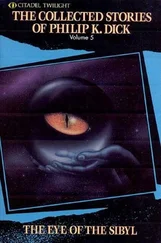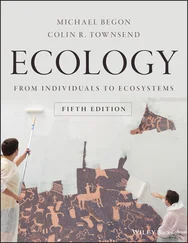392 375
393 376
394 377
395 378
396 379
397 381
398 382
399 383
400 384
401 385
402 387
403 392
404 393
405 395
406 397
407 404
408 405
409 406
410 408
411 409
412 410
413 411
414 412
415 413
416 414
417 415
418 416
419 417
420 418
421 419
422 420
423 421
424 422
425 423
426 424
427 425
C. Philip Wheater
Manchester Metropolitan University
Manchester
UK, M1 5GD
Penny A. Cook
University of Salford
Salford, UK, M5 4WT
James R. Bell
Rothamsted Research, Harpenden, AL5 2JQ, UK /
Manchester Metropolitan University, Manchester
UK, M1 5GD
Second Edition

This edition first published 2020
© 2020 John Wiley & Sons Ltd
Edition History
Wiley (1e, 2011)
All rights reserved. No part of this publication may be reproduced, stored in a retrieval system, or transmitted, in any form or by any means, electronic, mechanical, photocopying, recording or otherwise, except as permitted by law. Advice on how to obtain permission to reuse material from this title is available at http://www.wiley.com/go/permissions.
The right of C. Philip Wheater, Penny A. Cook and James R. Bell to be identified as the authors of this work has been asserted in accordance with law.
Registered Offices
John Wiley & Sons, Inc., 111 River Street, Hoboken, NJ 07030, USA
John Wiley & Sons Ltd, The Atrium, Southern Gate, Chichester, West Sussex, PO19 8SQ, UK
Editorial Office
9600 Garsington Road, Oxford, OX4 2DQ, UK
For details of our global editorial offices, customer services, and more information about Wiley products visit us at www.wiley.com.
Wiley also publishes its books in a variety of electronic formats and by print‐on‐demand. Some content that appears in standard print versions of this book may not be available in other formats.
Limit of Liability/Disclaimer of Warranty
While the publisher and authors have used their best efforts in preparing this work, they make no representations or warranties with respect to the accuracy or completeness of the contents of this work and specifically disclaim all warranties, including without limitation any implied warranties of merchantability or fitness for a particular purpose. No warranty may be created or extended by sales representatives, written sales materials or promotional statements for this work. The fact that an organization, website, or product is referred to in this work as a citation and/or potential source of further information does not mean that the publisher and authors endorse the information or services the organization, website, or product may provide or recommendations it may make. This work is sold with the understanding that the publisher is not engaged in rendering professional services. The advice and strategies contained herein may not be suitable for your situation. You should consult with a specialist where appropriate. Further, readers should be aware that websites listed in this work may have changed or disappeared between when this work was written and when it is read. Neither the publisher nor authors shall be liable for any loss of profit or any other commercial damages, including but not limited to special, incidental, consequential, or other damages.
Library of Congress Cataloging‐in‐Publication Data
Names: Wheater, C. Philip, 1956‐ author. | Cook, Penny A., 1971‐ author. |
Bell, James R., 1969‐ author.
Title: Practical field ecology / C. Philip Wheater, Penny A. Cook, James R. Bell.
Description: Second edition. | Hoboken, NJ : Wiley‐Blackwell, 2020. |
Includes bibliographical references and index.
Identifiers: LCCN 2019034790 (print) | LCCN 2019034791 (ebook) | ISBN
9781119413226 (paperback) | ISBN 9781119413233 (adobe pdf) | ISBN
9781119413240 (epub)
Subjects: LCSH: Ecology–Research–Methodology. | Ecology–Fieldwork.
Classification: LCC QH541.2 .W54 2020 (print) | LCC QH541.2 (ebook) | DDC
577.072–dc23
LC record available at https://lccn.loc.gov/2019034790
LC ebook record available at https://lccn.loc.gov/2019034791
Cover Design: Wiley
Cover Images: 3D Color Bar © victorhe2002/Getty Images, Frog © Design Pics/Corey Hochachka/Getty Images, Mouse © Graham Codd/EyeEm/Getty Images, Ladybird © Jacky Parker Photography/Getty Images, Cropped Hand Of Person Holding Magnifying Glass © Prakasit Khuansuwan/EyeEm/Getty Images, Close‐Up Of Water Drops © Yuttasak Thongsan/EyeEm/Getty Images
Since the publication of the first edition, three highly skilled field scientists who gave generously of their time and expertise for the first edition of this book have sadly passed away. All three were expert ecologists and each influenced many generations of young scientists.
We would like to dedicate this second edition to our friends and colleagues: Mike Hounsome, Rob Strachan, and Derek Yalden.
Preface to the Second Edition
Ecology is a rapidly evolving subject, not least in the techniques available to the field ecologist. Since the publication of our first edition of this project guide, advances have been made in several areas, most notably those that take advantage of modern technological developments. Whilst field ecologists have always sought to invent new methods and improve existing ones for monitoring plants and animals, new mobile technologies increasingly enable the tools for identification and verification of organisms to be literally in a researcher's back pocket. Similar advances in mobile phone apps have facilitated environmental monitoring, which has the potential to reduce the amount of equipment the researcher has to carry and perhaps go some way to providing standardisation of monitoring tools. There has been continued refinement of previously laboratory‐based techniques that provide access to information more cheaply and immediately in the field where once we would have had to take samples back to sophisticated laboratories for analysis. Further developments in other technologies have opened up new and exciting opportunities to survey our environment (in the case of drone technology, the sky is literally the limit!). As these developments bed in, it is appropriate to review the tools available to field researchers.
We have extended this second edition to cover a wider range of methods, with a special focus on more recent developments, emphasising the direction of travel of modern field ecology. Following positive feedback from many students and colleagues, we have increased the number of case studies, which demonstrate the realities of working in the field. Developments have also been made recently in the analysis of ecological data, and this is reflected in a broader coverage of some of the more accessible techniques and available software. Since communication of scientific results is highly relevant in today's confusing mix of fact and opinion, we have also expanded our coverage of presentation skills to include publishing in scientific journals and presentation at conferences.
We have been privileged to have had expert advice and constructive criticism from a large number of experts who, in addition to the input to the first edition of this book, have reviewed the plans and implementation of the second edition, provided case studies and photographs, read and commented on individual sections, and generally encouraged us in our endeavours.
Читать дальше













